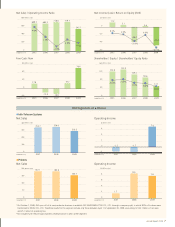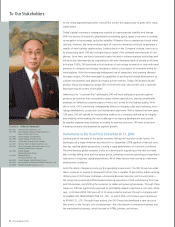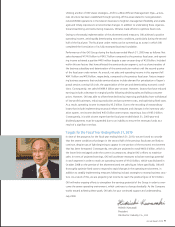Oki 2009 Annual Report Download - page 19
Download and view the complete annual report
Please find page 19 of the 2009 Oki annual report below. You can navigate through the pages in the report by either clicking on the pages listed below, or by using the keyword search tool below to find specific information within the annual report.
Annual Report 2009 17
쏹쏹쏹
Development of the World’s First 160Gbps Ultra High-Speed Optical Next Generation
Access Asymmetric PON System
OKI succeeded in the development of the world’s first 160Gbps ultra high-speed optical next generation
access (NGA) asymmetric PON system using its unique hybrid Optical Time Division Multiplexing (OTDM)
and Optical Code Division Multiplexing (OCDM). Transmitting signals downstream at a speed of 160Gbps
on a single optical fiber enables high-quality video delivery service, such as movie distribution and
telemedicine, and will vitalize local communication environment.
The mainstream optical access systems used by carriers today belong to the GE-PON system (1.25Gbps)
in Japan and G-PON system in the United States and Europe (2.5Gbps) are used mainly to transmit data and
video. With such optical access systems, the communication capacity per user when 16 users are connected,
is limited to 78 to 156Mbps.
OKI’s new system significantly increases the communication capacity compared with conventional optical
access systems. The system achieves 128-times larger capacity than GE-PON systems and 64-times larger
capacity than G-PON systems. This means that with 16 users, telecom carriers can offer a 10Gbps
communication capacity for each user, enabling high-resolution, high-quality video delivery service. The
research was conducted as part of the “Research and development for ultra high-speed optical NGA
Asymmetric PON system,” under the auspices of NICT’s “Basic Technology Promotion System for Private
Sectors Program.”
쏹쏹쏹
Development of a Small Sound Source Separation Module to Extract Sounds from
Specific Directions
OKI developed a small sound source separation module for embedded devices to separate and pick up
sounds from specific directions. Packaging the “sound source separation technology” into a compact
module of 4.5cm҂4.5cm҂1.0cm with the ability to processes signals from multiple microphones, this
product can be installed in small equipment.
Sound source separation technology is for isolating a target sound from multiple audio sources or a
varied environment with mixed sounds. This technology has attracted attention for its ability to improve
deteriorated sound quality and speech recognition performance when sound source other than the person
speaking is mixed when telecommunicating remotely or performing speech recognition with devices such as
mobile phone handsets, navigation systems and teleconference systems. Using the conventional sound
source separation method, however, a number of microphones are required; therefore, it is difficult to
achieve a smaller sized system. Given this situation, OKI, jointly with Waseda University, developed a sound
source separation technology that separates and extracts sound from a specific direction* with only a small
number of microphones, and based on this technology, OKI realized a small sound source separation
module that can be mounted on a mobile phone handset or other equipment. Adopting this module enables
clearer communications by controlling noise even in loud situations when participating in a teleconference
or speaking on a mobile phone. In addition to this feature, this module can prevent howling during
communication. Furthermore, in combination with speech recognition technology, this product can be
mounted in in-vehicle handsets or the remote controllers of home appliances to realize voice-activated
operations.
* Sound source separation technology that separates and extracts sound from a specific direction: This technology was
jointly developed with Professor Tetsunori Kobayashi of Waseda University as a part of the “2007 Strategic
Cultivation of Technologies” by the Ministry of Economy, Trade and Industry.
OLT (Optical Line Terminal), the main
equipment of this system
Small sound source separation module
























